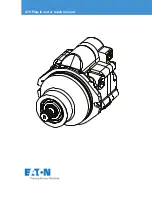
48 l
Installation, operation and maintenance manual – Squirrel cage motor – WGM20 Line 14108242
ABNORMALITY
POSSIBLE CAUSES
CORRECTION
Stator winding becomes very
hot under load
Insufficient cooling due to dirty water
channels
Clean the water passage channels
Overload
Measure the stator current. Reduce the
load. Analyze the motor application
High number of starts or moment of inertia
too high
Reduce the number of starts
Voltage too high, therefore, the iron losses
increase
Do not exceed 110% of the rated voltage,
except when otherwise specified on the
nameplate
Voltage too low, therefore, the current is
very high
Check the supply voltage and the voltage
drop on the motor
Interruption in a power cable or in a winding
phase
Measure the current in all the phases and, if
necessary, correct it
Rotor drags against the stator
Check the air-gap, operating conditions
(vibration etc.), bearing conditions
The operating condition does not
correspond to the nameplate data
Keep the operating condition according to
the nameplate or reduce the load
Unbalance in the power supply (blown fuse,
wrong command)
Check if there is voltage unbalance or
operation with two phases and correct it
Dirty windings
Clean the windings
Rotation direction is not compatible with the
used fan
Check the fan regarding to the motor
rotation direction
Noisy operation when
uncoupled
Unbalance
Perform new balancing
Interruption in one phase of the stator
winding
Measure the current of all connecting cables
Fastening screws are loose
Retighten and lock the screws
The rotor balancing conditions become
worse after the assembly of the coupling
Balance the coupling
Resonance in the foundation
Adjust the foundation
Motor frame deformed
Check flatness of the base
Bent shaft
Check the rotor balancing and eccentricity
Air-gap is not even
Check shaft warping or rolling bearing wear
11
ENVIRONMENTAL INFORMATION
11.1
PACKAGE
Electric motors are supplied in cardboard, polymer, wood
or metallic material packages. These materials are
recyclable or reusable and must be properly disposed
according to the current regulations of each country. All
the wood used in the packaging of WEG motors comes
from reforestation and receives anti-fungal treatment.
11.2
PRODUCT
Electric motors, under the constructive aspect, are
manufactured mainly with ferrous metals (steel, cast iron),
nonferrous metals (copper, aluminum) and plastic.
The electric motor, in general, is a product that has a long
useful life; however, when it must be disposed, WEG
recommends that the materials of the packaging and of
the product be properly separated and sent for recycling.
The non-recyclable materials must be properly disposed
according to the environmental regulations, i.e., in
industrial landfills, co-processed in cement kilns or
incinerated. The service providers for recycling, disposal in
industrial landfills, co-processing or incineration of waste
must be properly licensed by the environmental agency of
each state to carry out these activities.
11.3
HAZARDOUS WASTE
Grease and oil waste used to lubricate the bearings
should be disposed, according to the instructions of the
relevant environmental agencies, because its improper
disposal can cause impacts to the environment.




































